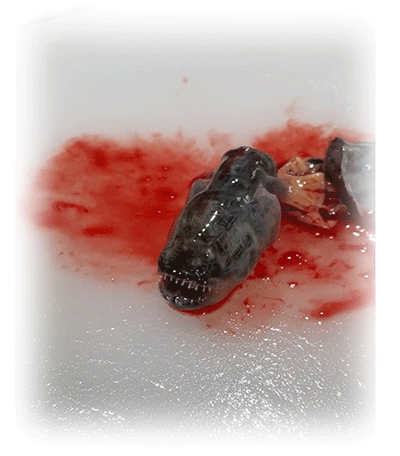| Please access the following URL if you want to secure using SSL. All pages in the site will be secure pages. |
https://secure02.blue.shared-server.net/www.fish-food.co.jp/message english 6.2023.html |
Welcome to FISH FOOD TIMES
June. 2023 issue No.234

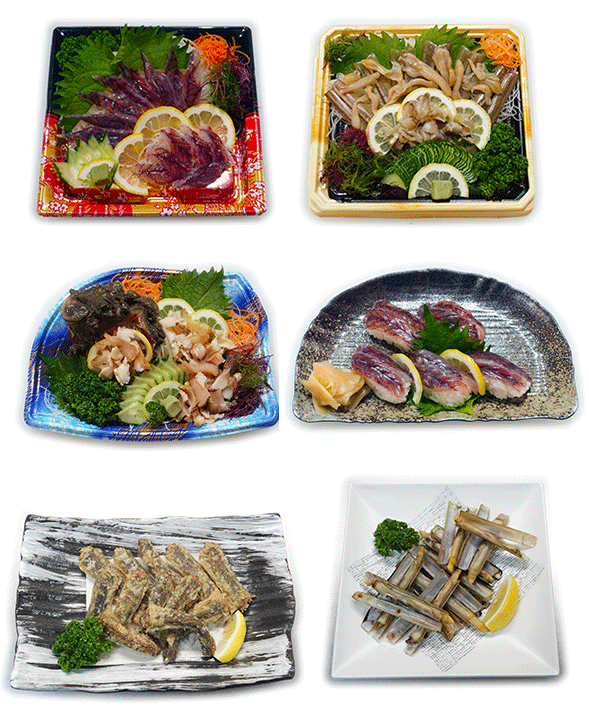
Rare fishs in the Ariake Sea
A fish that lives in tidal flats at zero meters above sea level.
Last month's issue was Mehikari (Greeneyes), a deep-sea fish. However, in this month's issue, I would like to introduce some of the rare fish that live in the Ariake Sea, which is the complete opposite, with tidal flats at sea level and a stretch of shallow water 6km offshore.
The name of the Ariake Sea was officially used after the war in 1951 on the 1:50,000 topographic map of the Geospatial Information Authority of Japan. Until then, the northern sea area was called Chikushi Sea or Chikushi Lagoon, and the southern sea area of Saga Prefecture and Nagasaki Prefecture was called the Ariake Sea.
The Ariake Sea is a stretch of shallow water with an average depth of about 20m and a tidal range of 3m to 5m. It is thought that the cause of the large tidal difference is resonance caused by the movement of seawater due to the tide called tidal oscillation. There are many rivers that flow into it, including the Chikugo River, which is the longest and largest in Kyushu. Although the water carried from the river dilutes the salinity, large tides agitate the sediment carried by the river, depositing it at low tide and eroding it at high tide, a constant cycle. As a result, the salinity of the seawater is evened out, and a vast tidal flat is also created.
In addition, the Ariake Sea has a basin-like topography surrounded by mountains on all sides, so there is a large daily temperature difference, and the water temperature in the bay also fluctuates greatly from season to season. For this reason, the Ariake Sea has formed a unique biota even within Japan, and is home to many rare fish.
The topography and environment are not the only reasons why the Ariake Sea has so many creatures that are rarely seen in other areas of Japan. Since this area had prehistoric connections with the East China Sea and the Yellow Sea, it seems that there are many organisms that are common to these sea areas, and such organisms are called continental relict species. These rare fish are basically eaten mainly in some areas facing the Ariake Sea, such as Yanagawa City and Okawa City in Fukuoka Prefecture, where they are served as one of the local cuisines.
Yoake Cyaya
Although I live in Fukuoka Prefecture, I have few opportunities to eat rare fish from the Ariake Sea, which is partly in contact with Fukuoka Prefecture. The fact is that I haven't had many opportunities to handle these until now, and to put it bluntly, I don't know much about these kinds of fish. However, from the standpoint of a job like the author, I think it can't be helped that people doubt my experience level if I don't know anything about rare fish in the Ariake Sea and have never eaten them. So, I apologize that this is a little old story, but in July 2017, I went to Yanagawa City, Fukuoka Prefecture for the purpose of eating all the rare fish dishes from the Ariake Sea. We visited a restaurant run by a fishmonger called Yoake Chaya, which has a history of about 130 years, and enjoyed a variety of fish from the Ariake Sea. This was already 6 years ago, so my memory is vague and I don't remember the taste well, but I left the images of the dishes, so let's introduce them first.
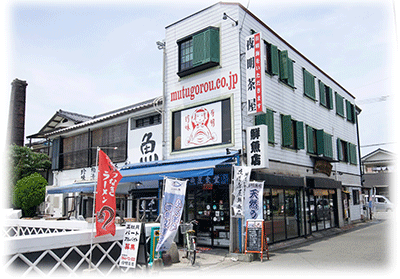
About 130 years ago, in 1890, it was still difficult for women to advance into society. During that time, Kiyo Hirano, the founder of Yoake Chaya, opened a fresh fish shop, Hirano Shoten, in the place that was then called Okinohata, now called Inaricho, Yanagawa City. At that time, the waters near Okinohata were one of the most prominent fishing grounds in the Ariake Sea, and the business expanded from a fresh fish shop to a fishermen's boss by taking advantage of the geographical advantage. Kiyo Hirano, the first generation, loved sake and was good at interacting with people. It is said that she served "sake" called "tea" to the fishermen who set out at dawn to pray for their safety and good catch. Then, at some point, Hirano Shoten became popular among fishermen and came to be called "Yoake Chaya", which is the current name of the store.
In other words, Yoake Chaya is a fishmonger that has been around for 130 years. When you enter the store, you'll find that it's just a fish store, with an assortment of products centered on fish from the Ariake Sea, as shown in the image below.
| Fish counter in Yoake Chaya | |
|---|---|
 |
 |
| mudskipper | Chinese razor clam |
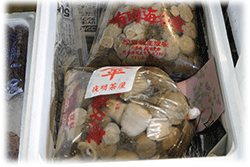 |
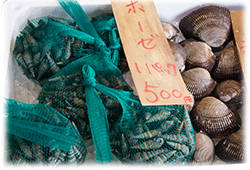 |
| wakenoshinnosu(sea anemone) | houze(multiformis) |
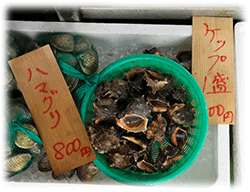 |
 |
| kettpu(rock shell) | majaku(Japanese mud shrimp) |
 |
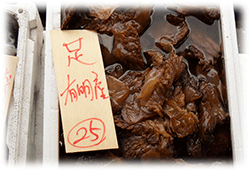 |
| Umitake & live shell | akakurage(edible jellyfish) |
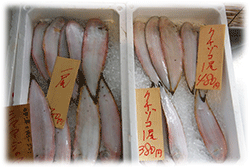 |
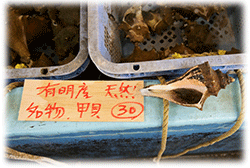 |
| kuchizoko(sole) | kouke(alse fusus) |
And on the same floor there is a table for chairs and a table for koagari, so there are about 10 tables in total. There is a cafeteria, and it is designed to let you eat the fish sold at the fish counter.
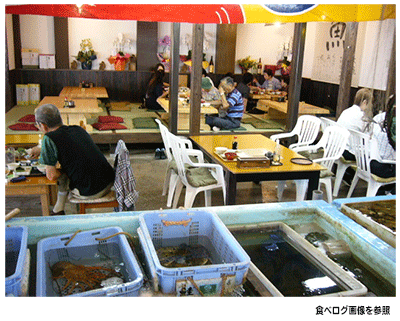
Six years ago, in July 2017, and now in 2023, we have not confirmed how the appearance and cuisine of Yoake Chaya have changed. At that time, the following dishes were offered.
| Ariake Sea Cuisine at Yaoke Chaya | |
|---|---|
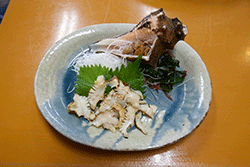 |
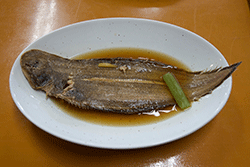 |
| kouke(alse fusus)sashimi | kuchizoko(sole)boiled fish |
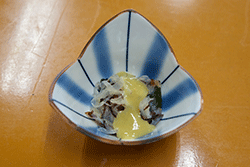 |
 |
| akakurage(edible jellyfish)vinegared food | Japanese mud shrimp deep-fried |
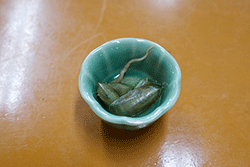 |
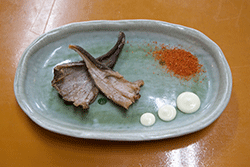 |
| mekaja boiled fish | dried umitake aburi |
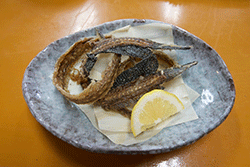 |
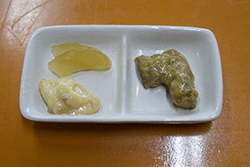 |
| mudskipper deep-fried bones | umitake Pickled in lees & sea anemone miso stew |
 |
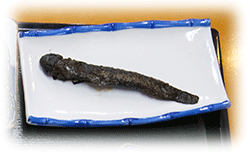 |
| eel goby & mudskipper figure sashimi | mudskipper candied simmered |
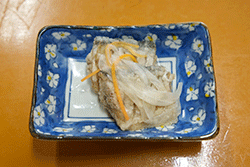 |
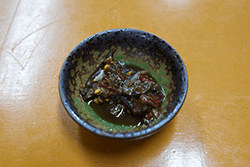 |
| Japanese grenadier anchovy namban pickles | ganizuke(wimming crab boiled down in soy) |
| Dried eel goby and dried mudskipper purchased as souvenirs at Yoake Chaya | |
|---|---|
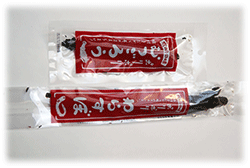 |
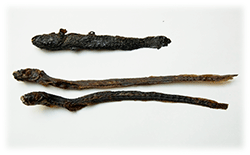 |
| Packing style | above is mudskipper、below is eel goby |
A bit lowbrows as a representation, but a facial image of the dried eel goby that has come to be known as the alien of the sea.
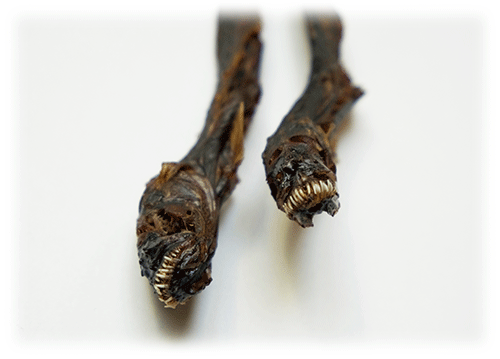
Eel goby
The image above is a dried eel goby, a fish mummy, so to speak, but a close-up image of a living eel goby is below.

And the overall picture of eel goby is below, but it was alive and well even though it was left for more than 7 to 8 hours after purchase. The eel goby moves around freely even when placed on a cutting board, and I couldn't take this photo at the angle I wanted, and I couldn't express the appearance of the eel goby.

I've handled and cooked a lot of fish in the past, but I don't think I've ever felt as creepy as this eel bogy to handle for cooking purposes. In cooking the eel bogy, I decided to cut off the head first. In the video below, even when the head is separated from the body, it moves with its mouth open and closed, so I hesitated to handle it with my bare hands. If you are not good at such videos, please skip without playing.
If the above video does not play, Youtube https://youtube.com/shorts/6kT73KH1mJI?feature=share I want you to visit here. |
|---|
The eel bogy is a goby family belonging to the Gobiidae family Gobies genus. It's long and slender like an eel, its scales aren't degenerated, and its skin is mucilaginous and slimy. This slimy fish skin makes eel bogy difficult to cook. This is because if you fix the head of an eel with meuchi, it will be easier to cook, but the eel bogy not only moves vigorously even after hours, but also has sharp teeth and moves its mouth. Therefore, instead of hitting meuchi, I wanted to remove the disgusting and unsightly head quickly. For this reason, the head was cut off one after another with a deba knife as shown in the image below. Then, the eel bogy's head and torso moved around frantically on the cutting board. It was like hell, and I felt like I was the Great King of Hell.
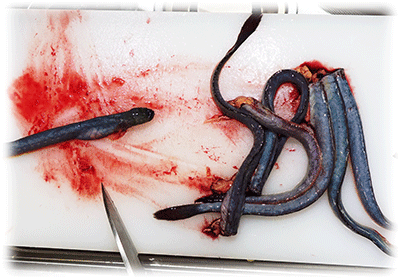
However, this time I cut off all the heads of the eel bogy I bought, which made me have to do a very difficult dismantling work.
| Dismantling process of eel bogy and sashimi/sushi | |
|---|---|
 |
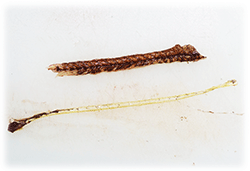 |
| 1,Scrape out the internal organs while pouring running water over it. | 7,stripped of skin |
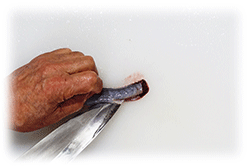 |
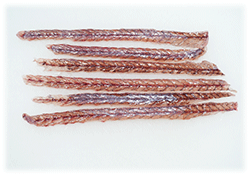 |
| 2,Cut open the abdomen from the anus with a reverse knife. | 8,3 eel bogy. The fish meat that has the skin removed is white flesh, but it has a reddish transparency. |
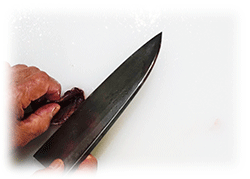 |
 |
| 3,Scrape out the remaining internal organs with the tip of the blade. | 9,Commercialize at usutsukuri sashimi. |
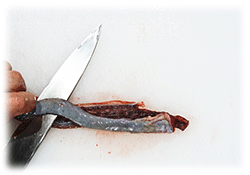 |
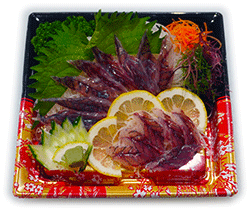 |
4,I made three pieces disassembling using the daimyo oroshi technique. The skin was slippery and slippery, making it unstable and difficult to grasp the small, thin shape. |
10,Eel bogy sashimi |
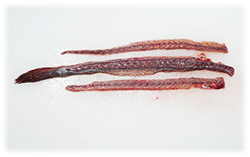 |
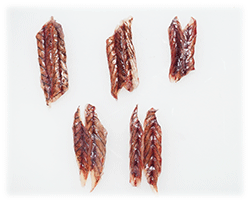 |
| 5,The state of three pieces disassembling. | 11,Cut the thin half body in half horizontally and overlap the two pieces to make a sushi topping. |
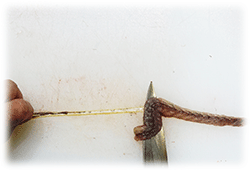 |
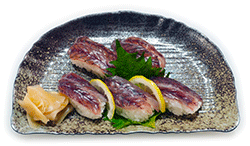 |
| 6,Skinning by the sotobiki method. The skin is thin but elastic, not easily cut and durable. | 12,Eel bogy nigiri sushi |
As mentioned above, dismantling the eel bogy was difficult due to the slimy mucus that was unstable. One point of reflection is that eel bogy needs to be rubbed with salt before cooking to remove as much mucus as possible, but that work may have been lenient. Another thing I thought I should try is to freeze the eel bogy with plenty of ice like a live eel and pierce the eel bogy, which has weakened in hibernation, with meuchi before dismantling it.
Next is the working process of karaage, which is very easy to prepare for eel bogy. However, it is actually a failure that cannot be recommended as a dish. Still, I want to tell you the fact that I failed like this.
| eel bogy deep-fried work process | |
|---|---|
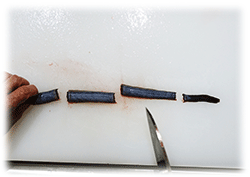 |
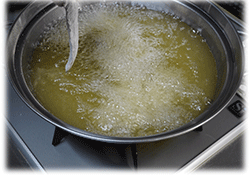 |
| 1,Cut one fish into 4 pieces. | 3,Fry the first time at 170 degrees for 10 minutes. |
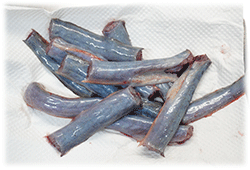 |
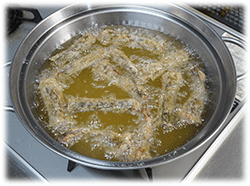 |
| 2,Before dusting with flour, rub salt to remove slime as much as possible. | 4,Fry for 8 minutes at 180 degrees for the second time. |
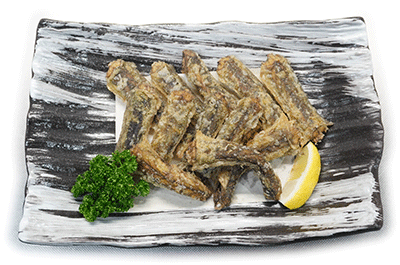 |
|
| ワラスボの唐揚げ | |
The deep fried eel bogy looked delicious, but unfortunately the centralbone was hard and chewy, so I couldn't say it was delicious. Actually, the person in charge of the store where I bought the eel bogy recommended me to make the eel bogy into boiled fish. However, when I tried deep frying contrary to that advice, I learned by actually cooking that eel bogy is not suitable for deep frying because the hardness of the bones was not removed.
Razor clam
It's been a long story about eel bogy, but this month's issue is about fish that live in the Ariake Sea, so I can't just talk about eel bogy. I bought two other types, so let me introduce this one as well.
The first is the razor clam. It is said that this name was given because the shape resembles the Japanese sword Metezashi (a short sword with a length of about 27 cm) in the image below.
The sword is usually held on the left hip, but the Metezashi is a sword held on the right hip and drawn with the right hand. This blade has a short blade of just under 27 cm (almost the same blade length as the Yanagiba syaku knife), so even if you pull it out with your right hand with the handle behind, you can pull it out without getting caught.
A razor clam with a shape similar to this sword uses its elongated shape to burrow vertically into the sand. If you put salt in a razor clam's burrow, the razor clam will come out mistaking it for a high tide. The clam digging method for catching razor clams has long been well known. However, razor clam populations have dwindled and are now becoming less common. Half of the razor clams I bought this time were a little troublesome, but I took a little time and effort to make them into sashimi, and the other half was grilled with salt.
| Razor clam sashimi | |
|---|---|
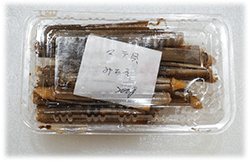 |
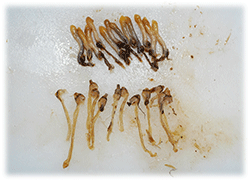 |
| 1,The container has the fisherman's name on it and contains 24 200g razor clams. | 6,A state separated into two parts, the water pipe and the leg part. |
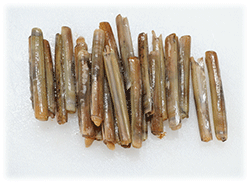 |
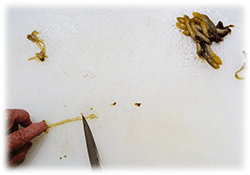 |
| 2,Twenty-four razor clams taken out of the container. The legs and water pipes are protruding and retracting from both sides. | 7,Scrape out the inedible parts from the water pipe using a tool such as a kitchen knife. |
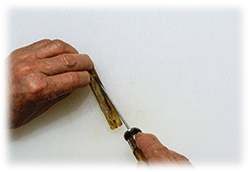 |
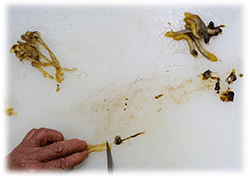 |
| 3,Open the shell lightly with your left hand, and use a Kaiokoshi to separate the adductor muscle. | 8,Remove internal organs from legs and internal organs parts. |
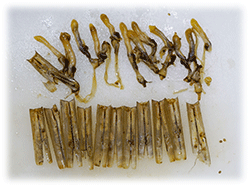 |
 |
| 4,The state where the shell part and the visceral part are separated. | 9,Legs on the left, water pipes on the right. Rub it with salt, wash it with water, and wipe off the moisture. |
 |
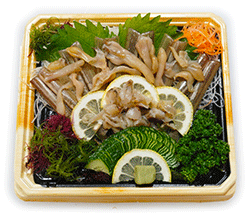 |
| 5,Using a kitchen knife, divide it into two parts, the water pipe part and the leg part including the internal organs. | 10、Spread the shells of the razor clam in a fan shape. And put the leg part on it. Place the water pipe on the sliced lemon in front to complete the razor clam sashimi. |
| Salt-grilled razor clam | |
|---|---|
 |
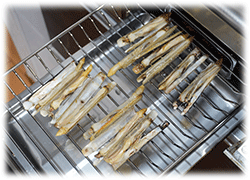 |
| 1,With the shell still attached, lightly wash it with water to wash off the inedible mud, and shake it with salt. | 3,If you give it too much time, it will become tough and tasteless. For this reason, it ends when it has a grilled mark in 1 to 2 minutes. |
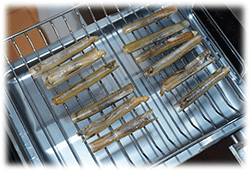 |
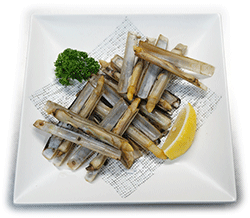 |
| 2,Arrange shell side down. | Salt-grilled razor clam |
The razor clam has little fat and a light taste, but it has a shellfish-like taste. For this reason, it was not a side dish of a meal, but suitable as a side dish with sake, and it was an elegant taste that could be eaten as much as possible. Compared to the grotesque appearance of eel goby, it was a very cute creature, and I felt that I wanted it to survive firmly in the tidal flats of the Ariake Sea.
Rock shell
Finally there is the rock shell. Rock shells are widely distributed from the south of Hokkaido to Kyushu, inhabiting the East China Sea and the vicinity of the Yellow Sea coast, and have been eaten in Japan since the Jomon period, and it seems that they were also used as accessories using the shells. Judging from this fact, as I wrote about the Ariake Sea at the beginning of this month's issue, it seems that this is also one of the "continental relict species" organisms.
In addition, rock shell seems to have been transplanted to areas such as the Black Sea where it originally did not inhabit, and since it has propagated in recent years, it is not only caught and eaten in Turkey and Bulgaria, but also exported. These are imported to Japan under the name of Top Shell, and seem to be used as a substitute for domestically produced turban shells. Processed foods such as canned foods, which are also called tsubogai and rokogai, seem to be mostly made from rock shell.
On the day I bought the rock shell, there was a mountain of rock shell in the fish section of the store where I always buy fish. I was advised by the fisheries manager, "This is also from the Ariake Sea, but it's cheap, so why don't you buy it?" I followed his advice and chose three pieces that were relatively large, just the size of my fist. And I was surprised when I was informed that the price was 200 yen for 3 pieces.
A real turban shell of this size would cost hundreds of yen, but I got one for about 70 yen. I thought that this was certainly cheap, so I put two pieces in one container for sashimi. Even so, the raw material cost of figure sashimi was only about 140 yen, and the following image was made at a low price.
| Rock shell figure sashimi process | |
|---|---|
 |
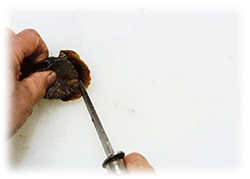 |
| 1,The cost of 3 rock shells is 200 yen. | 5,Put kaiokoshi between the lid and the body of the shellfish and remove the lid. |
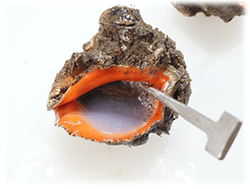 |
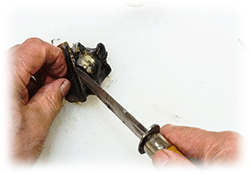 |
| 2,Execute the death penalty in meuchi. If you leave it as it is for a while, a large amount of cloudy white water will come out from inside. | 6,Use kaiokoshi to separate the meat and internal organs. |
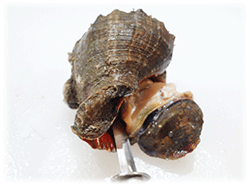 |
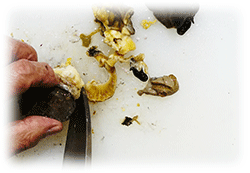 |
| 3,When the rock shell is killed and weakened, move the kaiokoshi counterclockwise to scoop out the contents. | 7,The part called hakama (string) that remains on the meat is scraped off with a kitchen knife. |
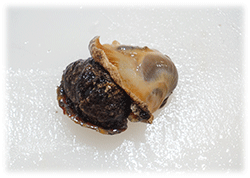 |
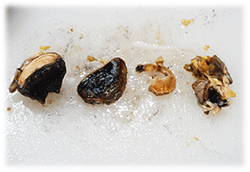 |
| 4,Parts of the legs and internal organs removed from the shell. | 8,Edible parts such as legs and other inedible parts. |
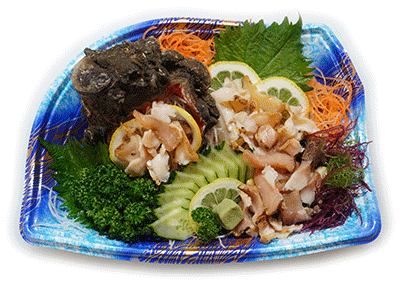 |
|
| Rock shell figure sashimi | |
Why is rock shell so cheap? Compared to the same conch turban shell, it's definitely cheaper. My wife said, "This is crunchy and the most delicious," and probably ate most of it by herself.
Ariake Sea is a treasure sea
Well, this month's issue has gotten a little too long, so it's time to wrap up. This is what happens when you pick up three types of fish and shellfish like this time, and also mention regional characteristics and restaurant menus. I shouldn't be too greedy about the content, but if I deal with only one kind of fish that is a little minor, the content may be thin on the contrary, and it is difficult to judge this area.
This month's issue is based on the theme of fish from the Ariake Sea, but I will end the article while leaving some points of concern. For example, for the third fish, rock shell, why is it so cheap? Is this simply because there is no demand in the relationship between supply and demand? Or did the rock shell occur abnormally and the price plummeted? It's probably not because it tastes bad and doesn't sell.
Of particular concern is that rock shells are carnivorous and produce acid from their feet that dissolves the calcareous matter of the shell. For rock shells, even if Japanese little neck, razor clams, and Chinese razor clams are tightly closed, the acid will pierce the shells and eat them. This time, when I used meuchi in a rock shell to kill it, a cloudy liquid came out from inside, but maybe that cloudy liquid was the liquid containing the acid.
There is no doubt that the more rock shells breed and increase, the more shellfish such as the Japanese little neck in the Ariake Sea will decrease in inverse proportion. As you know, sales of clams from Ariake Sea have been hit hard since the beginning of last year due to the misrepresentation of the origin of Japanese little neck clams. The original cause is that the Japanese little neck resources in the Ariake Sea have decreased significantly. The author believes that one of the reasons for the decrease in Japanese little neck population in the Ariake Sea is the ecology of rock shells.
When I see rock shells piled up in boxes in the fish section, I wonder what they eat and how they reproduce so much. The desertification phenomenon of the sea, called isoyake, is caused by the breeding of low-value skinny purple sea urchins and brassy chub, a predatory fish in seaweed beds that even fishermen dislike. Something similar to this may be occurring in the Ariake Sea.
Ariake Sea used to be called "Treasure Sea". There must be many people who still depend on the fisheries resources produced in the Ariake Sea for their livelihoods. In order to leave the Ariake Sea as a treasured sea for future generations, I think it is necessary for those involved in the sale of marine products to think carefully about what we should do.
| Please access the following URL if you want to secure using SSL. All pages in the site will be secure pages. |
https://secure02.blue.shared-server.net/www.fish-food.co.jp/message english 6.2023.html |
An opinion and the communication are to iinfo@fish food times
Date of updating 1 June. 2023

